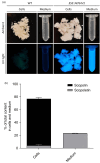Engineered coumarin accumulation reduces mycotoxin-induced oxidative stress and disease susceptibility
- PMID: 37578146
- PMCID: PMC10651151
- DOI: 10.1111/pbi.14144
Engineered coumarin accumulation reduces mycotoxin-induced oxidative stress and disease susceptibility
Abstract
Coumarins can fight pathogens and are thus promising for crop protection. Their biosynthesis, however, has not yet been engineered in crops. We tailored the constitutive accumulation of coumarins in transgenic Nicotiana benthamiana, Glycine max and Arabidopsis thaliana plants, as well as in Nicotiana tabacum BY-2 suspension cells. We did so by overexpressing A. thaliana feruloyl-CoA 6-hydroxylase 1 (AtF6'H1), encoding the key enzyme of scopoletin biosynthesis. Besides scopoletin and its glucoside scopolin, esculin at low level was the only other coumarin detected in transgenic cells. Mechanical damage of scopolin-accumulating tissue led to a swift release of scopoletin, presumably from the scopolin pool. High scopolin levels in A. thaliana roots coincided with reduced susceptibility to the root-parasitic nematode Heterodera schachtii. In addition, transgenic soybean plants were more tolerant to the soil-borne pathogenic fungus Fusarium virguliforme. Because mycotoxin-induced accumulation of reactive oxygen species and cell death were reduced in the AtF6'H1-overexpressors, the weaker sensitivity to F. virguliforme may be caused by attenuated oxidative damage of coumarin-hyperaccumulating cells. Together, engineered coumarin accumulation is promising for enhanced disease resilience of crops.
Keywords: coumarin; disease resistance; mycotoxin; reactive oxygen species; soybean; stress tolerance.
© 2023 The Authors. Plant Biotechnology Journal published by Society for Experimental Biology and The Association of Applied Biologists and John Wiley & Sons Ltd.
Conflict of interest statement
The authors H.S., U.C. and C.J.G.L. are inventors of project‐linked patent WO/2016124515. H.S. is an employee of BASF Plant Science Company GmbH. S.F.B. is an employee of BASF SE. U.C. and C.J.G.L. are employees of AgPrime GmbH.
Figures







Similar articles
-
Scopoletin is biosynthesized via ortho-hydroxylation of feruloyl CoA by a 2-oxoglutarate-dependent dioxygenase in Arabidopsis thaliana.Plant J. 2008 Sep;55(6):989-99. doi: 10.1111/j.1365-313X.2008.03568.x. Epub 2008 Jun 10. Plant J. 2008. PMID: 18547395
-
Identification of QTLs affecting scopolin and scopoletin biosynthesis in Arabidopsis thaliana.BMC Plant Biol. 2014 Oct 18;14:280. doi: 10.1186/s12870-014-0280-9. BMC Plant Biol. 2014. PMID: 25326030 Free PMC article.
-
Genes to specialized metabolites: accumulation of scopoletin, umbelliferone and their glycosides in natural populations of Arabidopsis thaliana.BMC Plant Biol. 2024 Aug 27;24(1):806. doi: 10.1186/s12870-024-05491-w. BMC Plant Biol. 2024. PMID: 39187756 Free PMC article.
-
The Age of Coumarins in Plant-Microbe Interactions.Plant Cell Physiol. 2019 Jul 1;60(7):1405-1419. doi: 10.1093/pcp/pcz076. Plant Cell Physiol. 2019. PMID: 31076771 Free PMC article. Review.
-
The Coumarins: Secondary Metabolites Playing a Primary Role in Plant Nutrition and Health.Trends Plant Sci. 2021 Mar;26(3):248-259. doi: 10.1016/j.tplants.2020.10.008. Epub 2020 Nov 25. Trends Plant Sci. 2021. PMID: 33246890 Review.
Cited by
-
Synthesis of Coumarin-Based Photosensitizers for Enhanced Antibacterial Type I/II Photodynamic Therapy.Molecules. 2024 Aug 10;29(16):3793. doi: 10.3390/molecules29163793. Molecules. 2024. PMID: 39202872 Free PMC article.
-
Effects of feruloyl-CoA 6'-hydroxylase 1 overexpression on lignin and cell wall characteristics in transgenic hybrid aspen.Front Plant Sci. 2025 Mar 28;16:1543168. doi: 10.3389/fpls.2025.1543168. eCollection 2025. Front Plant Sci. 2025. PMID: 40225026 Free PMC article.
-
Crop rotation alleviates continuous cropping obstacles in Chrysanthemum morifolium production by regulating rhizosphere soil microbial communities and metabolites.Environ Microbiome. 2025 Jul 17;20(1):90. doi: 10.1186/s40793-025-00754-x. Environ Microbiome. 2025. PMID: 40676696 Free PMC article.
-
Combined Metabolomics and Network Pharmacology to Reveal Anti-Diabetic Mechanisms and Potential Pharmacological Components of Synsepalum dulcificum.Plants (Basel). 2025 Jul 10;14(14):2132. doi: 10.3390/plants14142132. Plants (Basel). 2025. PMID: 40733369 Free PMC article.
-
Proteomic Profiling of Cocos nucifera L. Zygotic Embryos during Maturation of Dwarf and Tall Cultivars: The Dynamics of Carbohydrate and Fatty Acid Metabolism.Int J Mol Sci. 2024 Aug 4;25(15):8507. doi: 10.3390/ijms25158507. Int J Mol Sci. 2024. PMID: 39126077 Free PMC article.
References
-
- Abeysekara, N.S. , Swaminathan, S. , Desai, N. , Guo, L. and Bhattacharyya, M.K. (2016) The plant immunity inducer pipecolic acid accumulates in the xylem sap and leaves of soybean seedlings following Fusarium virguliforme infection. Plant Sci. 243, 105–114. - PubMed
-
- Ahn, Y.O. , Shimizu, B.I. , Sakata, K. , Gantulga, D. , Zhou, Z. , Bevan, D.R. and Esen, A. (2010) Scopolin‐hydrolyzing Beta‐glucosidases in roots of Arabidopsis. Plant Cell Physiol. 51, 132–143. - PubMed
-
- Albrecht, A. , Heiser, I. , Baker, R. , Nemec, S. , Elstner, E.F. and Osswald, W. (1998) Effects of the Fusarium solani toxin dihydrofusarubin on tobacco leaves and spinach chloroplasts. J. Plant Physiol. 153, 462–468.
Publication types
MeSH terms
Substances
Grants and funding
LinkOut - more resources
Full Text Sources

